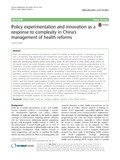Policy Experimentation and Innovation as a Response to Complexity in China’s Management of Health Reforms
| dc.contributor.author | Husain, Lewis | |
| dc.coverage.spatial | China | en |
| dc.date.accessioned | 2018-04-30T13:46:42Z | |
| dc.date.available | 2018-04-30T13:46:42Z | |
| dc.date.issued | 2017-08-03 | |
| dc.identifier.citation | Husain, L. (2017) Policy Experimentation and Innovation as a Response to Complexity in China’s Management of Health Reforms. Globalization and Health, (13) 54. | en |
| dc.identifier.uri | https://opendocs.ids.ac.uk/opendocs/handle/20.500.12413/13671 | |
| dc.description.abstract | There are increasing criticisms of dominant models for scaling up health systems in developing countries and a recognition that approaches are needed that better take into account the complexity of health interventions. Since Reform and Opening in the late 1970s, Chinese government has managed complex, rapid and intersecting reforms across many policy areas. As with reforms in other policy areas, reform of the health system has been through a process of trial and error. There is increasing understanding of the importance of policy experimentation and innovation in many of China’s reforms; this article argues that these processes have been important in rebuilding China’s health system. While China’s current system still has many problems, progress is being made in developing a functioning system able to ensure broad population access. The article analyses Chinese thinking on policy experimentation and innovation and their use in management of complex reforms. It argues that China’s management of reform allows space for policy tailoring and innovation by sub-national governments under a broad agreement over the ends of reform, and that shared understandings of policy innovation, alongside informational infrastructures for the systemic propagation and codification of useful practices, provide a framework for managing change in complex environments and under conditions of uncertainty in which ‘what works’ is not knowable in advance. The article situates China’s use of experimentation and innovation in management of health system reform in relation to recent literature which applies complex systems thinking to global health, and concludes that there are lessons to be learnt from China’s approaches to managing complexity in development of health systems for the benefit of the poor. | en |
| dc.language.iso | en | en |
| dc.publisher | BioMed Central | en |
| dc.rights | © The Author(s). 2017 Open Access. This article is distributed under the terms of the Creative Commons Attribution 4.0 International License (http://creativecommons.org/licenses/by/4.0/), which permits unrestricted use, distribution, and reproduction in any medium, provided you give appropriate credit to the original author(s) and the source, provide a link to the Creative Commons license, and indicate if changes were made. The Creative Commons Public Domain Dedication waiver (http://creativecommons.org/publicdomain/zero/1.0/) applies to the data made available in this article, unless otherwise stated. | en |
| dc.rights.uri | http://creativecommons.org/licenses/by/4.0/ | en |
| dc.subject | Health | en |
| dc.title | Policy Experimentation and Innovation as a Response to Complexity in China’s Management of Health Reforms | en |
| dc.type | Article | en |
| dc.rights.holder | © The Author(s). 2017 | en |
| dc.identifier.externaluri | https://globalizationandhealth.biomedcentral.com/articles/10.1186/s12992-017-0277-x | en |
| dc.identifier.team | Health and Nutrition | en |
| dc.identifier.doi | https://doi.org/10.1186/s12992-017-0277-x | |
| dcterms.dateAccepted | 2017-07-14 | |
| rioxxterms.funder | Default funder | en |
| rioxxterms.identifier.project | Default project | en |
| rioxxterms.version | VoR | en |
| rioxxterms.versionofrecord | https://doi.org/10.1186/s12992-017-0277-x | en |
| rioxxterms.funder.project | 9ce4e4dc-26e9-4d78-96e9-15e4dcac0642 | en |
Files in this item
This item appears in the following Collection(s)
Except where otherwise noted, this item's license is described as © The Author(s). 2017 Open Access. This article is distributed under the terms of the Creative Commons Attribution 4.0
International License (http://creativecommons.org/licenses/by/4.0/), which permits unrestricted use, distribution, and
reproduction in any medium, provided you give appropriate credit to the original author(s) and the source, provide a link to
the Creative Commons license, and indicate if changes were made. The Creative Commons Public Domain Dedication waiver
(http://creativecommons.org/publicdomain/zero/1.0/) applies to the data made available in this article, unless otherwise stated.


